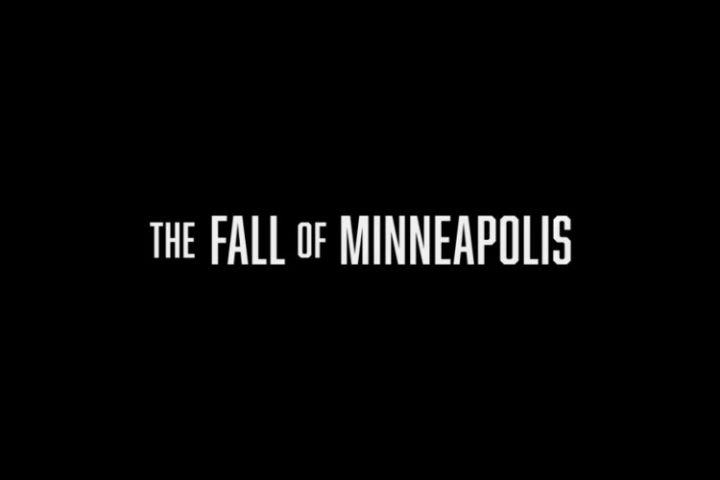
Former Minneapolis police officer Derek Chauvin was seriously injured on November 24 after another inmate at Federal Correctional Institution Tucson (Arizona) stabbed him around 1:30 p.m., according to the Associated Press. Chauvin, 47, was convicted in April 2021 of second-degree unintentional murder, third-degree murder, and second-degree manslaughter over the death of George Floyd. Chauvin was sentenced to 22½ years in prison on the state charges. Months later, he pleaded guilty to federal charges of depriving Floyd of his civil rights and was sentenced to 21 years in prison.
The illuminating documentary The Fall of Minneapolis reveals new and exclusive information that casts more than reasonable doubt on all the key claims of those who justified and encouraged the riots and violence that occurred as a result of Floyd’s death, which the mainstream media and their political allies blamed on the actions of Chauvin and the other officers. All sincere seekers of truth who watch this new documentary will be brought to reevaluate their previously held opinions and beliefs relating to this tragic story.
Background
On May 25, 2020, George Floyd, a 46-year-old black man, was arrested by Minneapolis police officers outside a local convenience store. The officers responded to a call from a store employee alleging that Floyd had used a counterfeit $20 bill. During the arrest, Officer Derek Chauvin participated in applying a restraint technique that ultimately resulted in his being tried and convicted of the charges listed above.
The arrest and subsequent death of Floyd, captured on bystander video, sparked widespread outrage leading to riots that ravaged Minneapolis and drew global attention to the case, including to the restraint techniques employed by Chauvin and his fellow officers. More than anything, the cellphone video recorded by a witness was the spark that ignited the fires that engulfed Minneapolis.
The Fall of Minneapolis: Setting the Record Straight
Directed by J.C. Chaix, The Fall of Minneapolis stands as a testament to the power of storytelling in capturing the complexities of contemporary societal issues. This film, meticulously produced by Liz Collin, a veteran journalist with a personal connection to Minneapolis, explores the turbulent events following the tragic death of George Floyd while in police custody on May 25, 2020. Collin, known for her extensive experience in news reporting and her commitment to unbiased journalism, brings a unique perspective to this documentary, blending journalistic rigor with cinematic storytelling.
The documentary opens with evocative scenes that immediately draw viewers into the heart of Minneapolis. Once a city celebrated for its serene parks and bustling cultural life, Minneapolis is now portrayed as a symbol of urban unrest and political discord. Through a mix of ground-level footage, exclusive interviews, and expert commentary, the filmmakers skillfully construct a narrative that is both informative, illuminating, and emotionally resonant.
One of the film’s key strengths lies in its in-depth exploration of the city’s descent into chaos. The documentary vividly captures the public’s grief and the ensuing protests following Floyd’s death. It presents a balanced view, showing how peaceful demonstrations were unfortunately overshadowed by violent riots and widespread destruction. This imagery serves as a powerful reminder of the fine line between rightful public outrage and anarchy.
Collin’s journalistic background is evident in the film’s examination of the political responses to these events. The documentary critically assesses the decisions of local leaders, particularly focusing on the “Defund the Police” movement. The film argues that these policies predictably led to unintended consequences such as a rise in crime and a sense of lawlessness that deeply affected the community’s sense of security.
Moreover, Collin ensures the documentary provides a balanced perspective by including the voices of law-enforcement officers who were on the front lines. These accounts offer valuable insights into the challenges faced by police in maintaining public order while they, themselves, were running for their lives as rioters stormed police precincts.
The Fall of Minneapolis is commendable for its even-handed approach. The documentary avoids partisan finger-pointing, instead presenting a nuanced picture of a city grappling with profound questions about justice, equity, and governance. This balanced viewpoint is a hallmark of Collin’s journalistic style, reflecting her commitment to presenting facts and diverse perspectives without bias.
Visually, the documentary is striking. Drone footage, street-level shots, police body-cam video, and archival material combine to create a vivid portrait of Minneapolis during the tumultuous time after the death of George Floyd. The filmmakers effectively use these visual elements to contrast the city’s peaceful past with its troubled present, adding depth and context to the narrative.
Collin’s documentary also situates the events in Minneapolis within a broader national context. It explores how the city’s struggles mirror larger tensions in American society, touching on themes such as racial inequality, political polarization, and the role of media in shaping public perception. This wider perspective makes the documentary relevant to a broader audience, extending its impact beyond those directly interested in Minneapolis.
Perhaps the documentary’s most valuable contribution to the chronicle of events surrounding the death of George Floyd, however, is its non-stop revelations of remarkable pieces of potentially exculpatory evidence that until now have been all but completely kept from the American people. These new facts and the new light they cast on the controversial and tragic tale of George Floyd and the officers who arrested him make The Fall of Minneapolis a must-see for any sincere seeker of truth.
What follows are some of the commonly held beliefs about the arrest, treatment, and death of George Floyd that are questioned — and often completely refuted — by the avalanche of evidence presented in The Fall of Minneapolis.
Derek Chauvin Placed His Knee on George Floyd’s Neck
Graphics from training manuals used by the Minneapolis Police Department demonstrate that the Maximal Restraint Technique (MRT) deployed by Chauvin and the other two officers charged in Floyd’s death was deployed by the officers in accordance with their training and with the instructions provided in the training manual.
In fact, the body-cam footage included in the documentary show that Chauvin’s knee was not on Floyd’s neck, but on his shoulder, below his neck.
The documentary points out, however, that the chief of the Minneapolis Police Department denied this demonstrable fact in his testimony at Chauvin’s trial. Why this critical and likely exculpatory evidence was not permitted at trial is questioned by the filmmakers.
This is not to suggest that the actions of the police were not arguably more forceful than necessary. Perhaps they were. What the documentary shows, however, is that had the officers been aware that Floyd appeared to have swallowed fentanyl and/or methamphetamine during the arrest, they would have taken greater care to avoid causing a spike in his blood pressure.
Some may doubt this assertion, but The Fall of Minneapolis features an interview with the officer that arrested Floyd a year prior to the arrest that resulted in his death.
Body-cam video from that arrest shows the officers catching Floyd swallowing pills during the arrest and remarking that they needed to take extra precaution to avoid even accidentally causing a heart attack, a reasonable presumption given the affect of fentanyl and methamphetamine on the heart.
Chauvin Kneeled on Floyd’s Neck for Nine Minutes, 29 Seconds
As the documentary demonstrates, the actual amount of time Chauvin had his knee on Floyd was seven minutes and 46 seconds. That didn’t stop politicians and bureaucrats and media outlets from stating as a “fact” that it was eight minutes, eight minutes and 46 seconds, nine minutes and 29 seconds, and 10 minutes.
The evidence of this is shown in the video, as well as clips of politicians and pundits inflating the time to suit the approved version of events.
The Evidence Presented in The Fall of Minneapolis Has Been Shown Before
Not true. The documentary offers officer body-cam views that were kept from the public until after the controversy died down. This body-cam footage reveals a different angle on Chauvin’s knee placement, as well as audio of the officers calling for EMS, asking Floyd if he was taking anything, if he was under the influence, and showing the errors committed by EMS that was completely out of the control of the police, for example.
The body-cam footage included in the documentary also appears to show Floyd attempting to swallow a white substance, presumably methamphetamine or fentanyl, something he did during his previous encounter with the police one year prior to the arrest that resulted in his death.
Regarding the previous police encounter, the producers include exclusive interviews with the officer who arrested George Floyd the year before the arrest that resulted in his death. This is a crucial interview, as Floyd pleaded with police not to shoot him because he claimed police shot him the last time he was arrested. Not only is this claim refuted, but the very body-cam footage proving that Floyd wasn’t shot and that he was in fact treated very humanely by police during his previous arrest is highlighted in the documentary.
The documentary also reveals documents related to the autopsy that include information demonstrating that Floyd’s blood contained more than twice the amount of fentanyl that has been known to result in an overdose. In fact, the documentary includes written testimony from a medical professional theorizing that the fentanyl in Floyd’s system likely led to an overdose. These facts were purposefully kept from the public, as well as the jury. There was certainly no mention or admission of these facts from the media, the bureaucrats, or the politicians calling for “justice” for the “murder” of George Floyd.
A Change of Venue Was Simply a Ploy to Get a More Sympathetic Jury
There is perhaps no moment where this documentary shines more brightly than in its raw and real depiction of the effect of the events of May 25, 2020 on the atmosphere in Minneapolis. One would be forgiven for believing he was watching footage of a city that had been shelled in war and then locked down in frightened response to the repercussions. The courthouse surrounded by barbed wire and the devastation already wrought in their city would have been sufficient evidence to convince any man or woman serving on the Chauvin jury what would happen to their hometown should they return anything less than a guilty verdict. There was little chance, under those conditions and with fires still smoldering within view, for the empaneling of an impartial jury as guaranteed by the Sixth Amendment to the U.S. Constitution. This jury was understandably partial, partial to peace and partial to not seeing their city descend further into chaos and crime.
The Officers Who Held Floyd Were Racists and He Was Treated Poorly Because He Was Black
The documentary reveals that two of the other officers convicted in the death of George Floyd are themselves people of color: J. Alexander Keung is black, and Tuo Thao is Hmong (Cambodian). These facts were suppressed, it appears, in a coordinated effort by the media and the politicians to fit the death of George Floyd into the mold of a racially motivated hate crime. It was nothing of the sort.
It is telling that the prevailing perception — even among that segment of the population prone to support the police — is that a white police officer used unnecessarily brutal force on a black man resulting in the murder of the latter. This incorrect version of the events is powerfully and persuasively debunked by the documentary produced by Collin.
Conclusion
No one would argue that the death of George Floyd was tragic, and perhaps avoidable. What should be argued, however, is the account of that tragedy conceived by politicians and constantly parroted by the mainstream media. A dispassionate viewing of The Fall of Minneapolis and a calm consideration of the facts presented in this documentary would lead to several nearly irrefutable conclusions: First, that this was not the murder of a black man by a racist police officer; second, that it was not a case of white police officers brutally manhandling a black man, causing his death; third, that the portrayal of George Floyd as a hero and Derek Chauvin (and, by extension, all law enforcement) as villains is inaccurate; fourth, that the police did not negligently wait to call for an ambulance; fifth, that Derek Chauvin did not kneel on Floyd’s neck for nearly 10 minutes; sixth, that George Floyd was not sober during his encounter with police; seventh, the members of the Minneapolis Police Department were trained in the use of the Maximal Restraint Technique used in the arrest of George Floyd; and, finally, the trial of Derek Chauvin was not fair and that the jury was influenced by the explosive atmosphere outside the courthouse.
Finally, George Floyd is not a victim. Derek Chauvin, Tuo Thao, and J. Alexander Keung are victims. The city of Minneapolis is a victim, the Sixth Amendment and justice are victims of the events of May 25, 2020, and the subsequent riots and trials.
With the release of The Fall of Minneapolis, the truth is revived.



